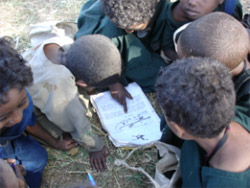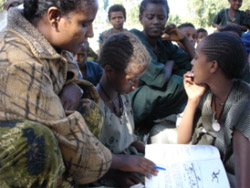Action research in North Gonder, Ethiopia
Negussie Shenkuti and Margarita Focas Licht
The development of a low-cost approach to providing primary education to excluded groups of children in rural areas is the main focus of a pilot inclusive schools project supported by Save the Children Norway. 1 The project began in October 2004 and involves school communities in a reflective process to question exclusion and identify means of inclusion. Resource teachers, who have some training in special needs education, are developing their capacity to become support teachers for inclusive classrooms. They assist classroom teachers in finding ways to include excluded groups in the learning process. The pilot will provide a basis for advocating changes in policy and practice at the regional and federal level. In this article Negussie and Margarita talk about the way a set of action research guidelines,2 developed by EENET, is being used and adapted.
Presence, participation and achievement
A number of workshops have been held with resource teachers and teachers of mainstream classes. In the first workshop the teachers were introduced to the principles and approaches of inclusive education. The concept of ‘presence, participation and achievement’ was also introduced. The teachers were facilitated to discuss what these terms meant to them, and to ‘dig deeper’ into the meanings. They then discussed who is or is not present, participating or achieving in their context.
‘Presence, participation and achievement’ is the idea that inclusion/exclusion is multi-layered: we need to look at who is or is not present; who is or is not participating when present; and who is or is not achieving and benefiting from such presence and participation.
Case studies
The teachers did their own classroom observation and investigation work (into ‘presence, participation and achievement’) and presented case studies at the next workshop. The case studies mostly focused on individual students, with teachers’ assumptions about why they are or are not present, participating or achieving. A wide range of issues was raised, including:
- children’s work burden at home is a problem
- divorce of parents affects children’s learning
- many married girls attend primary school and need special attention
- teachers’ classroom practices determine children’s learning.
The case studies also highlighted what was lacking in the schools, eg:
- information gathering from different sources
- co-operation between teachers
- focusing on every child
- involvement of the school in combating harmful traditional practices.3
Teachers continued in their schools to investigate further and see how they could take steps to address the problems identified.
Look, think, act
At the third workshop participants were introduced to the ‘look, think, act’ cycle. This means looking at what we do in schools that is inclusive or exclusive; thinking about this in detail and analysing what we have found out; and then taking action to improve the situation. The cycle continues when we look at the actions and the new situation and think about how to take further action to become more inclusive. Teachers worked in groups to discuss what needs to change, how it could be changed, who would be involved, how to record the process and results, how to communicate with stakeholders, etc. They also looked at the feasibility of each other’s suggested changes and at how to turn general statements into specific actions. Teachers raised issues such as:
- different approaches are needed to address presence, participation and achievement with different children
- parents’ involvement will ensure success
- this approach has made us realise ‘research’ is not difficult
- the approach is a way of creating knowledge for teachers to improve practice.
Teacher mobility
At this workshop a common problem hampered progress a little. Many teachers had been re-assigned to different classes or schools, and so this affected the investigations and presentations. In Zambia the redeployment of teachers on a regular basis has also, at times, interrupted the development of a consistent, ongoing cycle of action research. This is something that is beyond the control of practitioners or supporting NGOs. It needs to be addressed by decision makers if ongoing improvements are to be supported – or if inclusion and school improvement is to be sustainable.
Supporting disabled children
At the fourth workshop there was a development in positive thinking about supporting disabled children. One group of teachers reported the efforts they had made to register the disabled children. They had submitted a proposal to the school administration to mobilise resources for their inclusion. These changes in teachers’ attitudes led to requests for specific training on disability issues for mainstream teachers, which will be built into future workshops. At this workshop teachers also began to express an understanding of the need to involve children in addressing exclusion.
The challenge of writing
The teachers’ written reports have improved since the project started but they are not used to writing. Often what they presented orally was quite different from what had been written. A specific writing workshop was planned to address this. The project will also build on EENET’s experiences with image-based action research methods to develop non-written ways of capturing and presenting inclusive education ideas and experiences.
Research
The workshops produced some encouraging surprises. For example, the facilitators had not used the term ‘research’ to describe the processes they were taking the teachers through. However, during the workshops the teachers began to talk in terms of research. They commented that it is not complex, but is something that anyone can do to improve their work.
‘We used to think that when children weren’t learning it was their fault. Now we know that it may be because of a problem they have, that we can do something about’ Teacher, North Gonder
Disability and inclusion
The facilitators did not talk about inclusion in terms of disability. This was a deliberate strategy in order to encourage the teachers to think broadly about all issues of marginalisation. While disability was raised, so were plenty of other issues. This helped the teachers to see inclusive education as a process of system change to benefit all learners, not just as a way of assisting disabled learners.
Teachers working together
Moves towards teacher collaboration have been witnessed – in an environment where teachers have always worked in isolation! For example, teachers have discussed large class sizes. This is not a problem they should have to struggle with alone, but should work together to solve.
Notes
1 In collaboration with Chilga District Education Office under an agreement with the Amhara Regional Education Bureau.
2 See Useful Publications for details.
3 Such practices include early or forced marriage and female genital mutilation.
In May 2005, a team from Ethiopia visited Mpika, Zambia, where school communities are also using action research approaches in their school improvement work. The Ethiopian team was able to observe classroom practice, talk with teachers, and participate in image-based action research activities with children. They learned new ideas from, and were able to share their ideas with, the Zambian teachers. The visit enabled them to reflect in more depth on their own situation in Ethiopia.
Margarita is Education Adviser and Negussie is Project Co-ordinator in Save the Children Norway Ethiopia:
PO Box 6589
Addis Ababa
Ethiopia
Email: MargaritaFL@scne.org
 |
 |